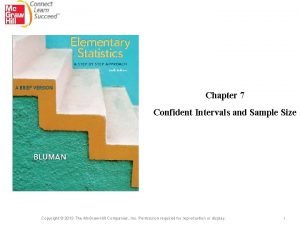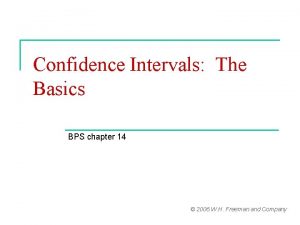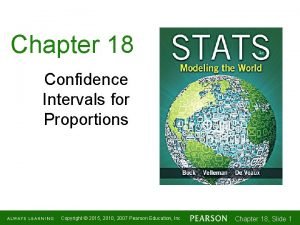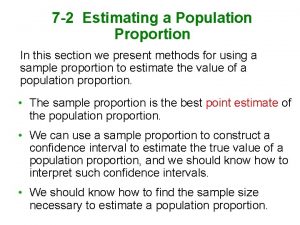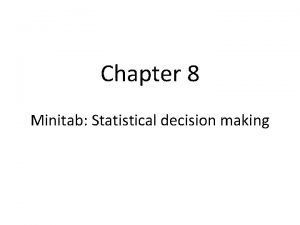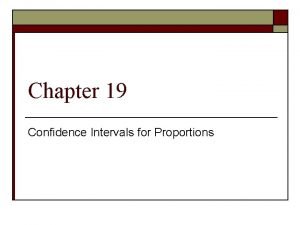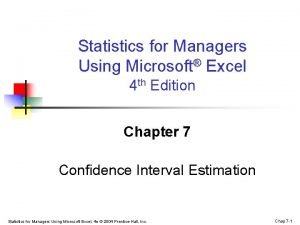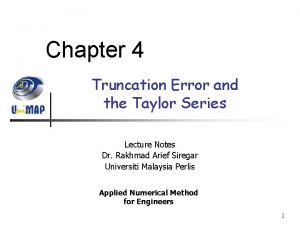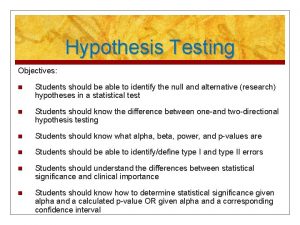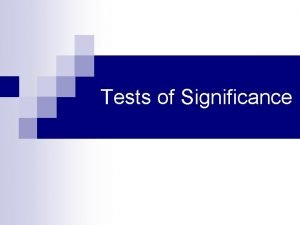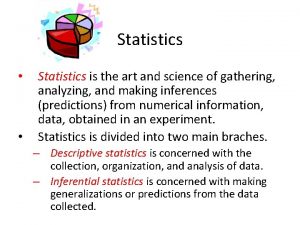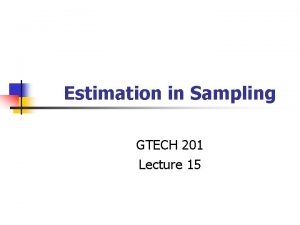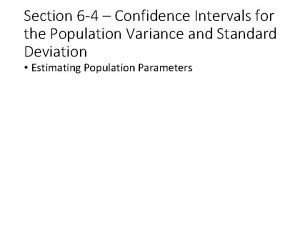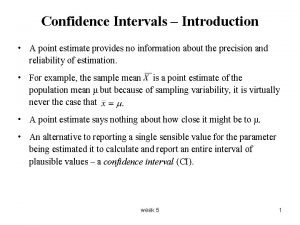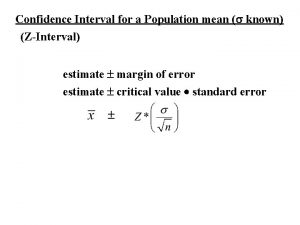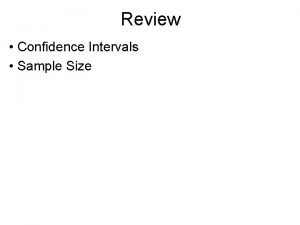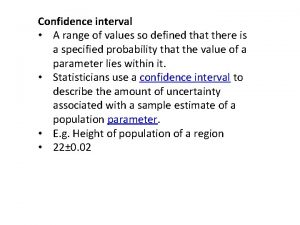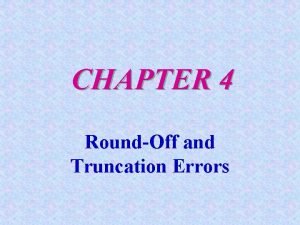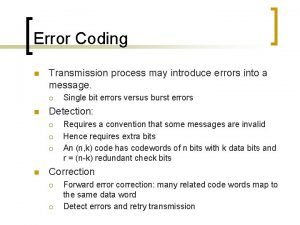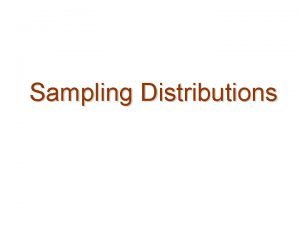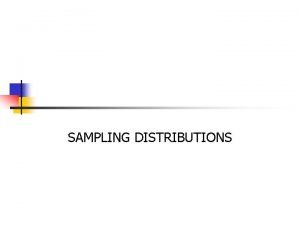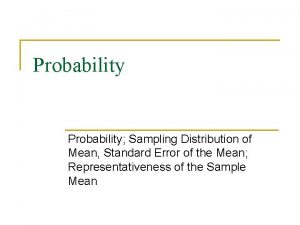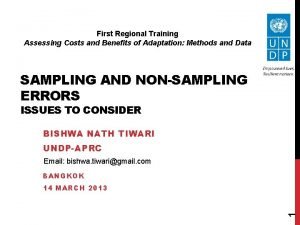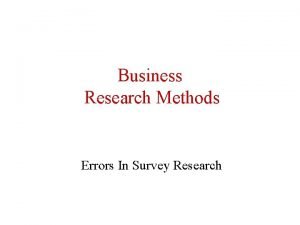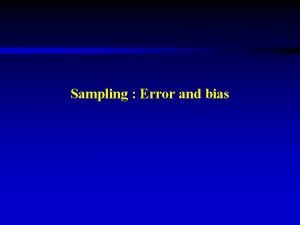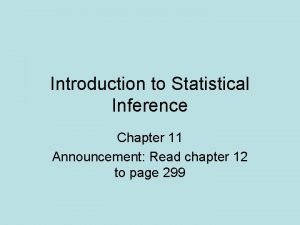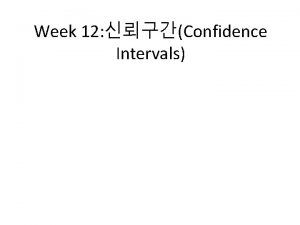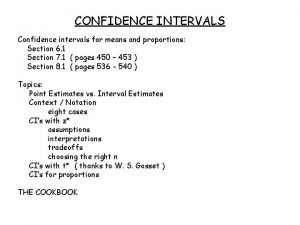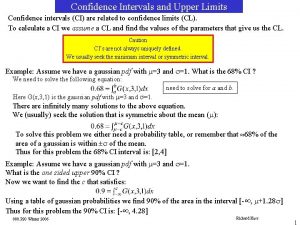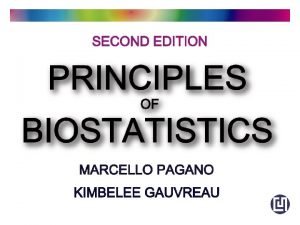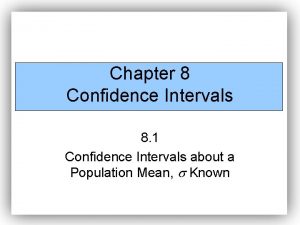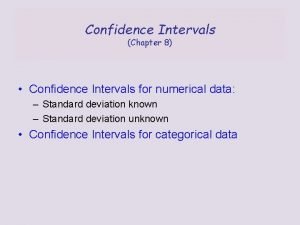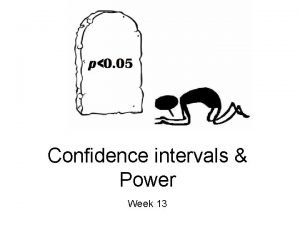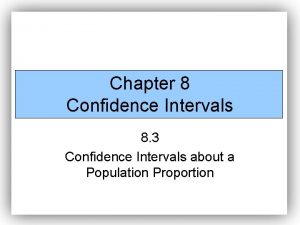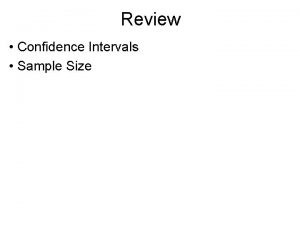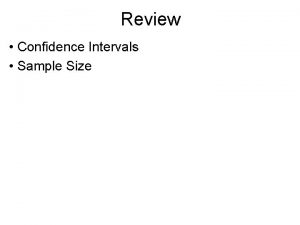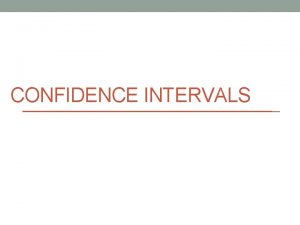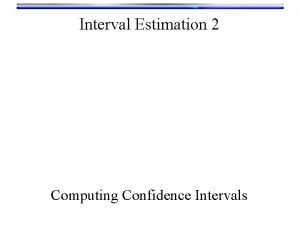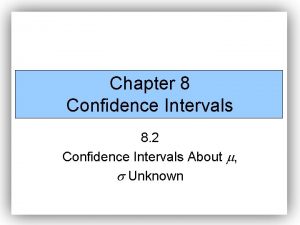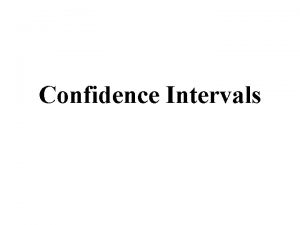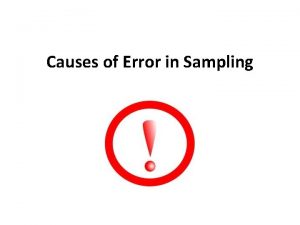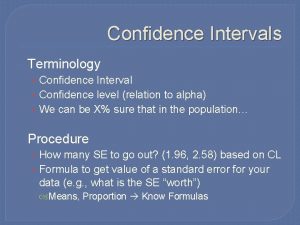CHAPTER6 Sampling error and confidence intervals Parameter population





![[Example 1] The population mean of DBP in the Chinese adult men is 72 [Example 1] The population mean of DBP in the Chinese adult men is 72](https://slidetodoc.com/presentation_image/bc74af9f2dbd91b2b16781a4f47d5161/image-6.jpg)

















































- Slides: 55

CHAPTER-6 Sampling error and confidence intervals

Parameter population error statistic sample

Section 1 sampling error of mean Section 2 t distribution Section 3 confidence intervals for the population mean

Section 1 sampling error of mean

A simple random sample is a sample of size n drawn from a population of size N in such a way that every possible random samples n has the same probability of being selected. Variability among the simple random samples drawn from the same population is called sampling variability, and the probability distribution that characterizes some aspect of the sampling variability, usually the mean but not always, is called a sampling distribution. These sampling distributions allow us to make objective statements about population parameters without measuring every object in the population.
![Example 1 The population mean of DBP in the Chinese adult men is 72 [Example 1] The population mean of DBP in the Chinese adult men is 72](https://slidetodoc.com/presentation_image/bc74af9f2dbd91b2b16781a4f47d5161/image-6.jpg)
[Example 1] The population mean of DBP in the Chinese adult men is 72 mm. Hg with standard deviation 5 mm. Hg. 10 adult participants was chosen randomly from the Chinese adult men, here we can calculate the sample mean and sample standard deviation. Supposing sampling 100 times, what’s the result?

N linkage

If random samples are repeatedly drawn from a population with a mean μ and standard deviation σ , we can find: 1 the sample means are different from the others 2 The sample mean are not necessary equal to population mean μ 3 The distribution of sample mean is symmetric about μ HOW TO EXPLORE THE SAMPLING DISTRIBUTION FOR THE MEAN?

The difference between sample statistics and population parameter or the difference among sample statistics are called sampling error.

v In real life we sample only once, but we realize that our sample comes from a theoretical sampling distribution of all possible samples of a particular size. The sampling distribution concept provides a link between sampling variability and probability. Choosing a random sample is a chance operation and generating the sampling distribution consists of many repetitions of this chance operation.

Central limit Theorem Ø When sampling from a normally distributed population with mean μ, the distribution of the sample mean will be normal with mean μ

=10 = 50 Population distribution n=4 n =16 X X Sampling distribution

Central limit Theorem Ø When sampling from a nonnormally distributed population with mean μ, the distribution of the sample mean will be approximately normal with mean μ as long as n is larger enough (n>50).

X

Standard error (SE) can be used to assess sampling error of mean. Although sampling error is inevitable, it can be calculated accurately.

Calculation of standard error (SE) ü theoretical value ü estimation of SE s↑→SE↑ n↑→SE↓ linkage

v Example 5. 2 One analyst chose randomly a sample (n=100) and measured their weights with a mean of 72 kg and standard deviation of 15 kg. Question: what is the standard error?

Solution:

Exercise 5. 1 Consider a sample of measurement 100 with mean 121 cm and standard deviation 7 cm drawn from a normal population. Try to compute its standard error.

Solution:

Section 2 t distribution

1. Definition N(μ, 2) N(0, 1)

Random sampling

Usually standard deviation σ is unknown, so we can only get s, then we can calculate

This sampling distribution was developed by W. S Gossett and published under the pseudonym “student” in 1908. it is, therefore, sometimes called the “student’s t distribution and is really a family of distributions dependent on the n-1.

Z distribution t distribution =n-1

2. the characteristics of t distribution graph FIG 4 the graph of t distribution with different degrees of freedom

v 1 symmetric about 0; v 2 the shape of t curve is determined by degree of freedom, df=n-1. v 3 t-distribution is approximated to standard normal distribution when n is infinite.


t critical value with one-sided probability → t(α, ) t critical value with two-sided probability → t(α/2, )

Example 5. 2 With n=15, find t 0 such that P(-t 0≤t≤ t 0 )=0. 90

solution From t value table, df=15 -1=14, the twotailed shaded area equals 0. 10, so -t 0=-1. 761 and t 0 =1. 761

Section 3 confidence intervals for the population mean

Statistical methods descriptive statistics inferential statistics parameter estimation Point estimation hypothesis test Intervals estimation

1. Basic concepts Parameter estimation: Deduce the population parameter basing on the sample statistics

ØPoint Estimate A single-valued estimate. A single element chosen from a sampling distribution. Conveys little information about the actual value of the population parameterabout the accuracy of the estimate.

ØConfidence Interval or Interval Estimation An interval or range of values believed to include the unknown population parameter.

Point estimation Intervals estimation Lower limit Upper limit

a/2 1 -a a/2

2. Methods Z distribution 1. σ is known 2. σ is unknown ,n> 50 CI t distribution σ is unknown,n≤ 50 CI

Example 5. 3 A horticultural scientist is developing a new variety of apple. One of the important traits, in addition to taste, color, and storability, is the uniformity of the fruit size. To estimate the weight she samples 100 mature fruit and calculates a sample mean of 220 g and standard deviation 5 g Develop 95% confidence intervals for the population mean μ from her sample

solution 95% confidence intervals for the population mean is between 219. 02 and 220. 98 g

Exercise A forester is interested in estimating the average number of ‘count trees’ per acre. A random sample of n=64 one acre is selected and examined. The average (mean) number of count trees per acre is found to be 27. 3, with a standard deviation of 12. 1. Use this information to construct 95% confidence interval for μ.

solution 95% confidence intervals for the population mean is between 24. 36 and 30. 24

The forester is 95% confident that the population mean for “count trees” per acre is between 24. 36 and 30. 24

Example 5. 4 The ecologist samples 25 plants and measures their heights. He finds that the sample has a mean of 15 cm and a sample deviation of 4 cm. what is the 95% confidence interval for the population mean μ

solution df=25 -1=24

The plant ecologist is 95% confident that the population mean for heights of these plants is between 13. 349 and 16. 651 cm

Exercise 1 one doctor samples 25 men and measures their heights. He finds that the sample has a mean of 172. 12 cm and a sample deviation of 4. 50 cm. what is the 95% confidence interval for the population mean μ

solution 95% confidence intervals for the population mean is between 170. 26 and 173. 98

Exercise 2 Random samples of size 9 are repeatedly drawn from a normal distribution with a mean of 65 and a standard deviation of 18. Describe the sampling distribution of mean.

65 Lower limit Upper limit


PROBLEM 1. What are the difference of SD and SE? 2. What is the medical reference range? What is the confidence intervals for population mean?

 Chapter 7 confidence intervals and sample size
Chapter 7 confidence intervals and sample size Significance and confidence level
Significance and confidence level 96 confidence interval z score
96 confidence interval z score Reporting confidence intervals
Reporting confidence intervals Confidence interval definition
Confidence interval definition Critical value for 90 confidence interval
Critical value for 90 confidence interval Confidence intervals excel
Confidence intervals excel Chapter 18 confidence intervals for proportions
Chapter 18 confidence intervals for proportions Estimating a population proportion
Estimating a population proportion Calculate confidence interval ti 84
Calculate confidence interval ti 84 Confidence intervals minitab
Confidence intervals minitab Chapter 19 confidence intervals for proportions
Chapter 19 confidence intervals for proportions How to add 95 confidence intervals in excel
How to add 95 confidence intervals in excel Error intervals gcse questions and answers
Error intervals gcse questions and answers Error intervals significant figures
Error intervals significant figures Error interval questions
Error interval questions Error intervals worksheet
Error intervals worksheet Truncation error intervals
Truncation error intervals Confidence interval vs confidence level
Confidence interval vs confidence level Significance test
Significance test Statistics is science or art
Statistics is science or art Population parameter symbol
Population parameter symbol Confidence interval for population variance formula
Confidence interval for population variance formula What is the point estimate of μ?
What is the point estimate of μ? Confidence interval for population mean
Confidence interval for population mean Confidence interval with margin of error calculator
Confidence interval with margin of error calculator T statistic range
T statistic range Probability vs non probability sampling
Probability vs non probability sampling Objective of sampling
Objective of sampling Difference between cluster and stratified sampling ppt
Difference between cluster and stratified sampling ppt Contoh target perilaku dalam observasi
Contoh target perilaku dalam observasi Stratified sampling vs cluster sampling
Stratified sampling vs cluster sampling Non probability sample
Non probability sample Natural sampling vs flat top sampling
Natural sampling vs flat top sampling Purposive sampling in qualitative research
Purposive sampling in qualitative research Population vs sample
Population vs sample Type i error
Type i error Random and systematic errors examples
Random and systematic errors examples Round off vs truncation error
Round off vs truncation error Difference between error detection and error correction
Difference between error detection and error correction Absolute error definition
Absolute error definition Sampling distribution sample mean
Sampling distribution sample mean Sample error example
Sample error example Standard error
Standard error Sampling error examples
Sampling error examples Auspices bias example
Auspices bias example Real life example of sampling distribution
Real life example of sampling distribution Sampling bias
Sampling bias Standard error of sampling distribution
Standard error of sampling distribution Sampling error formula
Sampling error formula Chapter 4 section 1 population dynamics answer key
Chapter 4 section 1 population dynamics answer key Section 1 population dynamics
Section 1 population dynamics Population ecology section 1 population dynamics
Population ecology section 1 population dynamics Chapter 4 population ecology answer key
Chapter 4 population ecology answer key Type 2 vs type 1 error
Type 2 vs type 1 error Can a dead man gyro error
Can a dead man gyro error
